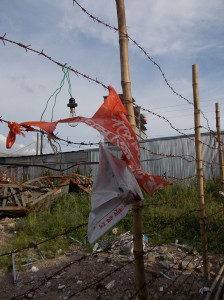M. Sophia Newman
Maybe I should kill myself,” my friend said as we walked down a street in Dhaka together.
He wasn’t joking. I wasn’t surprised. In April 2013, he had been at the collapse of Rana Plaza. The disaster had immediately killed 1,116 workers, and my friend, a journalist, had spent a week watching some die. He’d helped save a few of the 2,438 survivors.
I’d been there too, but more briefly – just long enough to understand the grim horror of dead bodies beneath shattered cement and tangled rebar. He’d come away sleepless, guilty, depressed – in a word, traumatised. Months later, as he worked to grasp what had happened, he mentioned his own death as a kind of relief.
Many people know the feeling. Many, including my friend, eventually recovered their natural good humor. But occasionally I still think of his words – like this week, when I read that another Rana Plaza survivor has died for lack of mental health care. Kohidur Islam Kajol, a worker who was trapped for days in the rubble, died this November 12 at National Institute of Cardiovascular Diseases. An article in Daily Star quotes his wife, Saleha: “He was really depressed and was under tremendous mental pressure,” she said, referring to the family’s financial pressures. “My husband could have been saved had he not been deprived of the proper treatment because of money,” she said.
In a way, the problem was the exact reason I’d come to Bangladesh. On the day I walked down the street with my friend, I was completing mental health research under a Fulbright fellowship, part of a large American international exchange programme. I came hoping to research culture and mental healthcare, but realizing that the real issue was just money.
I had little support for my work. Just before the disaster, I’d raised the issue of institutional neglect with a supervisor at the university where I’d affiliated. “Your dream isn’t worth having,” she’d said about my research, pooh-poohing the fifth of sixth protocols the university would request and spuriously reject.
The attitude was sadly common. Along with it came a neglect that was entirely unsustainable.
On the day Rana Plaza fell, I’d already learned that Bangladesh, a nation of 160 million, had just 123 psychiatrists. Information-gathering was even more neglected. In the past 20 years, just over 60 mental health studies have been published. (To make it clear how few that was: my own country had published perhaps a thousand times as many studies in that same time.)
Yet there is no doubt about need. Bangladeshis have the same propensity towards mental disorder as anyone else – including vulnerability to trauma. Before Rana Plaza, the number of mental health doctors available was sufficient to serve less than 1% of Bangladeshis who would benefit from mental healthcare.
After the Rana Plaza atrocity, psychiatrists from Bangladesh’s National Institute of Mental Health diagnosed mental illness in 1,780 of 1,998 survivors assessed, or 89.1%. Their families also have elevated psychological distress. Rescuers have been known to commit suicide, and journalists like my friend have been known to consider it. (Neither group was ever fully assessed.)
That terrible mental health burden was foreseeable within hours of the factory collapse. It is coming to fruition when people like Kajol bhai die for lack of mental healthcare. Yet 18 months later, most survivors have not received adequate help. A lot of survivors blame the lack of money, but they forget that hospitals, as well as they themselves, can need funding for the work.
Although the National Institute of Mental Health received funds to assess people, the funding body refused to provide the funds for treating those people. The institute is not big, and it doesn’t charge patients. The lack of money meant that they could not help these 1,780 survivors.
Meeting their needs is part of a global economic imperative. Mental health disorders are becoming the number one most common health problem worldwide. They account for about 14% of all disease worldwide, and heavily interfere with economic prosperity of individual workers and entire nations. Yet they receive only about 1% of healthcare expenditures worldwide. This neglect shortens the lives of severely impacted people, like Rana Plaza survivors. It also reduced the quality of life for many more.
But changes are coming to Dhaka. Over the time I lived in Bangladesh, I saw more and more people begin to understand the need for mental healthcare. In this, they are like most of the world. This is a problem, like garment industry exploitation, that people all over are ready to confront.
Policymakers need to confront it, too. The week we lose the worker Kohidur Islam Kajol is a good time to consider once more that funding – to families and to hospitals – is part of what makes surviving trauma possible. In his honor, and in the honor of people like my journalist friend, policymakers should consider funding for mental healthcare, now and at the next disaster.
Source: bdnews24










